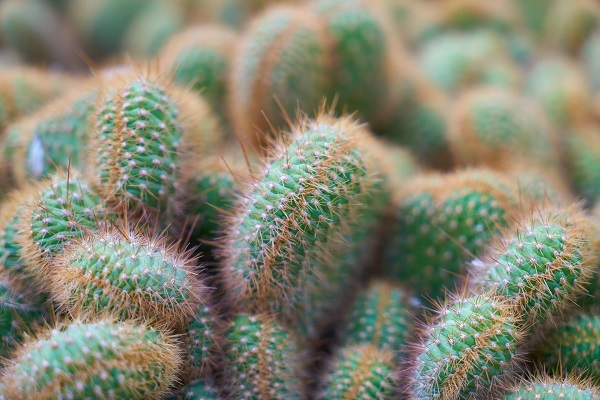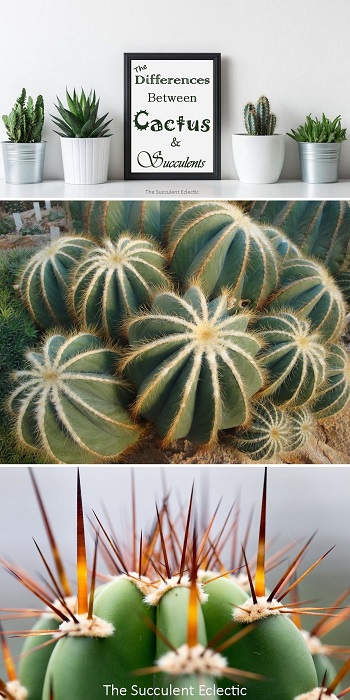Cactus and succulents are all the rage these days. Love for these über cool plants crosses divides of age, race, gender and even politics(!) But these terms are often used interchangeably, with big box stores often labeling all manner of cactus simply as “succulent”. So just what is a cactus? What is the difference between cactus and succulents? And how can you tell them apart? Read on to learn these answers and much more.
Cactus vs. Succulents — What You Need to Know
In this Post We'll Cover:
{Please note, some links in this post may be affiliate links to sites that pay me a small commission if you click on the link and make a purchase. This commission is at absolutely no cost to you. I only recommend products and companies that I have worked with and truly love! ~Kat}
What is a Cactus

Let’s start at the very beginning — what is a succulent plant? Any plant that stores water in its leaves, stems or roots for future use during times of drought is a succulent. The definition of a cactus is more narrowly drawn. So what is a cactus? A cactus is a succulent plant that stores water in its fleshy stem. Nearly all cactus have spines, no leaves, produce bright, complex flowers and bear fruit. So you can see that though all cactus are succulents, not all succulents are cactus.
So how to recognize which succulents are cactus? There are several characteristics that will help you to discern the difference between cactus and succulents:
- The look of most succulents is determined by the shape and arrangement of its leaves. The look of a cactus is determined by its stems.
- Cactus stems are typically fluted, ribbed or pleated.
- All cactus form areoles, but no other succulents do.
- Succulent flowers are small and simple. Cactus blooms are large, showy and complex.
- Succulents are most often propagated by leaf and cuttings. Cactus are most often propagated by seeds or offsetsSucculent offsets are the baby succulents that form at the b....
- Cactus produce fruit, through succulents do not.
Because most of this blog focuses on succulents, this post will be primarily about cactus and each of these characteristics. But first, some cool cactus facts!
Cool Cactus Facts

Cactus plants are an extraordinary group of plants among succulents, which are already pretty amazing. Here are just a few cactus facts you should know:
- The word cactus is singular. “Cactuses” is the plural in English; “cacti” is the correct plural in Latin.
- There are 127 cactus genera and nearly 1800 cactus species. Nearly all are native to the New World.
- Cactus varieties range in mature height from just half an inch to well over 60 feet tall!
- The largest cactus weighs in at a staggering 4,800 pounds.
- A full-grown saguaro cactus can take in and store as much as 200 gallons of water in a single rainstorm.
- Because leaves release moisture to the environment, cactus evolved spines in the place of true leaves.
- Unlike most plants, the cactus’ stem is its primary organ for photosynthesisPhotosynthesis (FO-to-SIN-thuh-sis) is the process plants us... More.
- All cactus produce fruit, much of it is edible by humans.
- Cactus plants live from 15-300 years, depending upon the variety.
My thanks to Leaf & Clay for the use of these photos of Opuntia rufiada minima ‘Mini Cinnamon Cactus’!
Cactus Stems and Forms

Unlike most succulents, with a cactus, it is the stems that determine the form of the plant. What might appear to be leaves on this lovely Opuntia Caudata, are actually segmented stems. The leaves of most plants, including succulents, perform two very important biological functions; photosynthesis, and transpirationTranspiration is the process of water movement through plant... More. Photosynthesis converts sunlight into energy for the plant’s growth and development. Transpiration is the release of water back into the atmosphere. Both cactus and succulents are native to very harsh, dry conditions. Cactuses evolved to forgo water loss from leaves, and to perform photosynthesis in their stems.
Thank you, Mountain Crest Gardens, for the use of these Opuntia basilaris ‘Caudata’ photos!
Cactus Ribs, Flutes and Pleats

Cactus and succulents are amazing plants, with extraordinary adaptations to hot, arid, drought-stricken climates. The most common shape for a cactus is a sphere because it is the shape that stores the most water with the least surface area through which moisture can be lost. But what about these deep ribs, pleats and flutes common to most cactus varieties? Surely they provide a lot of additional surface area, right? These cactus spheres will swell to completely flatten out these deep pleats when the rains come. They fill up with water, to the point that they are like so many water balloons! When the rains pass and the plants must draw upon their stores of water, over time, the water levels are depleted, and these pleats become more pronounced.
Cactus Spines

In place of true leaves, most cactus varieties produce spines that may be needle-like, bristly, hairy, wooly or even a combination of these textures on a single plant. These modified leaves perform several functions. First, they protect the water-rich flesh of the cactus from thirsting animals. Cactus spines also disrupt the air flow right around the stems of the cactus, to prevent excessive water loss, especially in drying desert winds. Further, each spine provides a small amount of shade for the plant. While this shade might seem minuscule, when multiplied by the thousands of spine each plant bears, it can produce real relief. In some cactus plants, spines also aid in reproduction. They catch in the fur of passing animals, causing a small chunk of the plant to detach. When it drops to the ground, it roots and begins to grow a new cactus.
Some succulents also produce spiky thorns. Euphorbia is a genus of succulents most often confused with cactus, due to their many thorns. The spikes on cactus are properly called “spines”, which are modified leaves. The “thorns” of other succulents are actually modified branches. Cactus spines typically are very narrow, and needle-like. They look as though they are piercing the skin, pushed through from the back. Thorns on succulents like euphorbia or agave, however, are generally much broader at their base than at their tip. These thorns look more like they are pulled from the skin of the plant, almost like taking a pinch of fabric between your fingers.
Cactus spines are often an important part of the overall appearance of the plant, from their size to their texture, to their arrangement to their color. Cactus spines may be bright orange, vivid red, electric yellow, stark white or a smokey shade of amber or gold. When backlit by the setting sun, cactus spines often catch the light and seem to glow from within, for a dazzling display.
Cactus Areoles

Cactus spines are always produced on small structures called areoles. All cactus, even the few without spines, have areoles. No other plant, succulent or otherwise, forms these areoles.
Areoles are a distinguishing characteristic of cactus. They are modified branches that appear as small round bumps that produce spines, blooms and shoots. All cactus have areoles, even those few without spines. Although some succulents produce plenty of bumps of one sort or another, these bumps do not produce spines, blooms or sprouts, and so, are not areoles.
Cactus Flowers

Cactus and succulents all bloom. But cactus flowers are far larger, showier and much more complex in their structure than those of other succulents. Each forms many petals and dozens of stamens, often in bright colors like red, pink, yellow, orange or even blue. Some cactus flowers are even highly fragrant. Cactus flowers are pollinated by hummingbirds, butterflies, moths, and bats.
Cactus Fruits

Though cactus and succulents both flower, only the cactus produce fruit. Cactus fruit is typically either hard and dry, or fleshy and juicy. While only a few are widely known, like the prickly pear fruit and dragon fruit, most fleshy cactus fruits are edible by humans. Cactus fruits have long been an important food source for peoples indigenous to the Americas. Spanish explorers took Opuntia ficus-indicia, the Indian fig cactus back home with them, where it quickly spread throughout the Mediterranean area and became an important commercial crop in Algeria and Sicily.
These seed-bearing cactus fruits are a boon to herbivores, birds, tortoises and other animals who live in the harsh conditions common to cactus. When the birds or animals eat the fruit, they wind up dispersing the cactus seeds widely, via their droppings. In this way, cactus seeds find new land to grow in, soon to develop new colonies of cactus plants. Even ants are known to spread the seeds of some cactus. Smaller, drier cactus fruit bear tiny spines that catch in the fur of passing animals, to later drop to the earth. In time, the fruit cracks, dispersing their seeds which begin to grow.
Where to Buy Cactus

Cactus varieties come in so many different sizes, forms and characters, no one place can offer more than a small fraction for sale. But I do have a couple of favorite vendors. Leaf & Clay offers a wonderful selection of cactus and succulents, but their selection of rare and unusual cactus varieties is really special. Their quality is consistently excellent. I especially love their many crested cactus varieties. Mountain Crest Gardens offers a beautifully curated selection of Opuntia, the prickly pear cactus with dazzling blooms.
Many thanks to Leaf & Clay for the use of this photo of Mammillaria schwarzii!
I hope you have enjoyed this review of the difference between cactus and succulents! If you have any questions, please feel free to leave a comment, and I will get right back to you.
Happy gardening!

P.S. For more great information on cactus and succulents, please subscribe! You will also receive my FREE course, 7 Steps to Succulent Success. Thanks!




